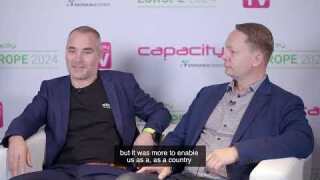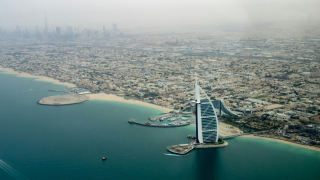Across the Middle East monumental structures are rising out of the desert, fashioned from steel, glass and concrete. Called cities, they aren’t urban conurbations in any conventional sense, rather glittering palaces bespoked for the needs of the giants of global commerce and their employees.
High-profile examples of the phenomenon include Dubai Internet City and Qatar Energy City, while dozens of lesser known imitations continue, through economic ups and downs, to sprout across the region, sponsored by governments intent on recasting their countries as international business hubs. What most have in common is a dominant central theme, which allied to a wealth of cutting-edge infrastructure is designed to attract attention and investment from the world’s multinational corporations.
Christine Lewis, senior analyst for the Middle East with the Buddecomm consultancy, observes that the governments backing these schemes appear at pains to best each other with the scale of their investment: “There seems to be a certain competitive element in this – ‘my Masdar City trumps your Dubai Internet City’,” she says. “The whole economic city business has been driven by the success of Dubai Internet City in attracting regional head offices to Dubai. But it is a success that builds upon itself once a critical mass is reached, so it’s difficult to replicate.”
If a measure of success is the volume of foreign investment already attracted, in defiance of wobbly economic conditions, then matters are well on track says Michael Ourabah, CEO of global managed services provider BSO Network Solutions.
“There’s interest from financial services, media companies and others,” he says. “Even in cities that aren’t yet completed, you can get a clear idea of the sort of business that’s going to develop. Often what you’re seeing is interest from Tier 2 and 3 type companies – hedge funds and smaller banks in the case of a financial city – who see a chance to set up operations in the region. There’s a wave of these types of companies looking at such a move. The recession has held up certain plans, but they’ll be happening at some stage.”
There is necessarily an intimate relationship between the construction of an economic city, and the provision of appropriate communications infrastructure to link it with other relevant locations around the world.
Symbiotic relationship
“All these cities have a symbiotic relationship with fibre capacity providers,” says William Fagan, executive director of ICT Qatar, Qatar’s national telecoms regulator. “The construction phase is the time for laying down major communications infrastructure. When the customers of these cities turn up, they want to find all the right turnkey facilities there. Cities and infrastructure – one enhances the other.”
Since last year’s economic troubles in Dubai, says Fagan, economic cities have been under pressure to prove their inherent viability and sustainability, and to demonstrate that they are not simply a speculative play by an over-ambitious property conglomerate.
“If a city is just a property investment, where’s the value?” he says. “Is it serving the oil and energy, financial or media industry? Has it got connections to Paris, New York or Rome? If it’s serving the oil industry, that had better be Houston. For these reasons, the communications infrastructure is as important as the construction of the actual city itself.”
Fagan says that in the case of economic cities, telecoms regulators have a more crucial part to play than ever in getting the balance right between government investment and private sector input into key infrastructure: “When it comes to terrestrial fibre, it’s the job of the regulator to see how much development the market will generate,” he says. “If the market’s working well, then too much government subsidy is going to be distorting. A company putting in fibre at their own expense will want an economic return.”
Set the bar high
Tarun Jaiswal is senior director for business development with Dubai-based operator Du. He says that with many developments styling themselves as a “smart” or “intelligent” city, the bar on information and communications technology delivery has been set high.
“These greenfield projects have the opportunity to incorporate the latest ICT infrastructure to deliver leading-edge services that benefit all stakeholders and user groups in those cities – building owners, residents, workers, tenants and visitors,” he says. “Here in the UAE, Du has led the way by investing in FTTx technology and is offering voice, high-speed data and the latest IPTV services to our customers over an all IP-based fibre network.”
He says IP-based networks are also suited for the carrying of various non-telecoms elements that add to a city’s lustre, such as home automation, CCTV, access control, energy management, digital signage and concierge services.
“This approach removes the need for duplicate networks and over-investment in IT infrastructure, and also means that these cities have the ability to manage and operate sustainably and cost-effectively,” he says. “But building cities is one thing, running them is quite another, and very often developers rush to build without planning for future operations.”
The required level of planning cannot, he believes, be managed in isolation by property developers, or their traditional partners in the construction industry: “It has to be done in partnership with service providers and technology vendors, who have a vested interest in planning for the life-cycle of these cities,” he says. “Dubai Internet City is a great example of how such collaborations can result in true innovation. The ICT infrastructure was a crucial factor in attracting leading technology and media companies to establish their regional hubs in Dubai.” He also cites Dubai International Financial Centre (DIFC) as another example of a planning effort shared between technology and construction sectors.
With economic cities intended to stimulate a rush of outside investors looking for a foothold in the region, it is perhaps natural that outsiders should have a role too in the initial creative stages. “We’ve invested in Qatar Energy City, with QTel as our partner,” says John Gibson, president of business development for Middle East and Africa at AT&T Global Business Services. “It’s going to attract a lot of companies in that sector to the region. Our role is to advise on the design of the city’s network infrastructure, to make sure it’s going to be what customers will demand. Large energy companies need a high level of service.”
Gibson says that through its Navlink subsidiary, AT&T has been instrumental in creating data centre facilities within Qatar Energy City: “There are now 1,000 racks of space,” he says. “That’s a major investment. From what we’re hearing from customers, there’s going to be a huge growth in data centre requirements in the region. It’s a logical transition following on from the creation of new communications infrastructure.”
Another development that AT&T has been involved in is Blue City in Oman, a $15 billion construction midway between the capital Muscat and Sohar: “It’s going to have 200,000 residents and five major hotels,” says Gibson. “We’re advising on infrastructure to meet the needs of customers. They are demanding smart homes with facilities like IPTV. Developers want to provide that, and are looking to network operators to deliver the sort of services that you’re now seeing in other parts of the world.”
Political motivation
Dubai-based analyst Mohsen Malaki, formerly with IDC and Delta Partners has been involved in an advisory role in a number of city projects, helping construction companies to plan the development of infrastructure. He has worked in Saudi Arabia, for example, where the government is planning six new cities, the first of which, King Abdullah Economic City, is nearing completion. “The objective of these cities is to stimulate the economies of the various countries, driving economies away from oil dependence and creating jobs for very young populations,” he says. “The political ramifications of high unemployment in places like Saudi Arabia are high. The government is very scared of the prospect – and this is one of the key drivers for these cities.”
Where the opportunity is seized and properly managed, new cities can end up enjoying a class of ICT set-up hardly matched anywhere on the planet, says Malaki: “Just look at the tallest building in the world that has just been finished in Dubai,” he says. “Both Du and Etisalat have been fitting it out with fibre, Wimax and HSxPA. Triple play runs throughout the whole structure, and that’s just one example of what’s going on.”
Ownership and alliances
A murkier area, he says, is how the complex networks of alliances between technology vendors, network operators and construction interests actually function. “As you look across the Gulf, you can see different models of infrastructure development being tried out,” he says. “Who’s managing it – the developer or the operator? Does the developer need to be applying for a telecoms licence? Or does it outsource everything to operators? Who then owns the cables and the ducts? What model is most viable? Du used to be in property development before going into telecoms, at the time unofficially licensed to build infrastructure and negotiate with companies like Microsoft. But of course entering the telecoms market is a big step. How far do you want to go? Does the regulator want you to go there?”
So far in the evolution of the Middle East’s economic cities, money has talked. The rewards for investors in a successful city are so high that in the rush for profit, some plans may be rubber-stamped without full consideration of the fine detail by all stakeholders. With global economic bust turning back into boom, the mad dash to build the biggest and the best may in some cases be sowing the seeds of future disharmony.
Where now for content hosting in the Middle East? |
Extensive investment in subsea cable links between the Middle East and the rest of the world is starting to be matched by progress on fibre backbone connectivity within and between countries. With domestic unwired and wired broadband markets also opening up, one old question remains: “Where is the development of internet content for Arabic-speaking consumers headed?” A supplementary question might be: “Where are the data centres in which locally-generated online material might be held?” “There is more Arabic internet content now, but it’s a slow growth process,” says Christine Lewis, senior analyst for the Middle East with the Buddecomm consultancy. “Yahoo’s purchase of Maktoob has made the rest of the world notice more. But anyone talking of a ‘boom’ in locally held content is going a bit far.” The majority of the content accessed from the Gulf is still created and hosted outside the region, concedes Andrew Grenville, executive vice president with Dubai operator Du. “There is a need for more relevant local content, and there are a growing number of excellent regional and local initiatives to create relevant Arabic and other local content,” he says. “Du is very supportive of this, for example in our sponsorship of the popular Freej project [family-oriented animation]. Recently Abu Dhabi announced twofour54, a content creation community. This trend combined with the inherent cost and inefficiency of hauling content all the way to and from Europe, the US or the Far East means there is certainly a need for more data centre hosting here.” As well as green shoots of locally developed online material, there are a number of media and new media companies based in Europe and elsewhere in the developed world looking at ways to make versions of their content available to Arabic speakers, says Michael Ourabah, CEO of carrier BSO Network Solutions, which has a PoP in Dubai. “You have dot coms and so on looking to replicate the data there that they hold in Europe,” he says. “There’s a big Middle East firewall around European and US content, as there is in China. You can go to a version of, say, the BBC news site but with some things filtered out.” Arguably a more pressing issue, says Ourabah, is a lack of places where data can be hosted regionally: “Real-estate space in places like Dubai Internet City is very expensive, too expensive to set up a major data centre there,” he says. “But if you want to build one outside the major cities, then power is an issue. It’s easier to buy network capacity in a city, but in Dubai that’s only from Etisalat or Du. You’re not talking about the same sort of business arrangements you’d find in Europe. If you want the same kind of experience you’d get in London in Dubai, we can uncomplicate it for you and handle all the difficult side of it.” Mohsen Malaki foresees that things must change as local content volumes grow, and IPTV, streaming video and social networking add to the burden on existing infrastructure: “Etisalat is streaming content to the region via satellite, and it’s not even being hosted in the UAE because of the cost of bandwidth,” he says. “It gets hosted in Europe. Assuming this multimedia demand keeps up, there will be hunger for more infrastructure connecting the region. A lot, of course, is dependent on broadband developments within individual countries. Once you have a nationwide broadband network in your country, the natural next step is to look across borders.” |




